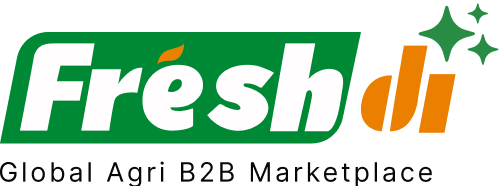🌱 Introduction – The Current Pulse of the Global Soybean Sector
The global soybean market is in the midst of a seismic shift as Week 23 of 2025 unfolds. Several critical developments are shaking up how businesses source, price, and plan for soybean procurement. From record-breaking production in Brazil to trade policy uncertainties with the EU and China, the landscape is anything but static.
In May 2025, the USDA projected global soybean production to hit an all-time high of 427 million tons for the 2025/26 season, largely credited to Brazil’s massive output. Simultaneously, adverse weather in the U.S. and Argentina is shrinking yields and tightening stockpiles. Add to that a looming expiration of the U.S.-China tariff truce, and we have a market on edge.
For businesses relying on soybeans—be it for plant-based foods, animal feed, or biofuel—staying agile and informed is no longer optional. Platforms like Freshdi are helping buyers keep up by offering verified supplier listings, RFQ (request-for-quote) insights, and real-time market trend data.
Let’s dive into the key updates and what they mean for your sourcing strategy.
📊 Deep Dive – Breaking News & Market Shocks in Week 23
Here’s what’s making headlines in the soybean market this week:
- Brazil’s dominance continues: In Week 23, Brazil is shipping record volumes, now responsible for 59% of global soybean exports.
- U.S. production slips: Due to poor weather and rising input costs, U.S. soybean stocks are down by 19% year-over-year.
- EU proposes pesticide ban: The EU is considering banning U.S. soybeans treated with certain chemicals, which could lead to price premiums for South American beans.
- Demand surging in Asia: Countries like China, Pakistan, and Bangladesh are increasing imports for food processing and feed production.
- Price volatility persists: Futures are bouncing between $9.10 and $10.25 per bushel as traders watch weather and trade policy developments.
🏆 Top 5 Verified Soybean Suppliers in Global – Week 23, 2025
In this fast-moving environment, supplier reliability and verification are key. Based on trade activity, user feedback, and credentials on Freshdi, here are the Top 5 Soybean Suppliers in Global for Week 23 of 2025:
1. Nature House Company
- Business Type: Exporter / Wholesaler
- Payment Term: To be discussed
- Trade Term: To be discussed
- Why They’re Ranked: Trusted for consistent bulk supply and strong customer service across Asia and the Middle East.
2. Richmond Florida Inc.
- Business Type: Exporter / Wholesaler
- Payment Term: To be discussed
- Trade Term: To be discussed
- Why They’re Ranked: Known for competitive pricing and quick turnaround on RFQs, especially in Latin American markets.
3. M.Trading Ventures
- Business Type: Exporter / Wholesaler
- Year Established: 2018
- Payment & Trade Terms: Flexible, to be discussed
- Why They’re Ranked: Strong logistics network in Brazil and active in real-time RFQ responses, verified by Freshdi.
4. Solasta Global Trading
- Business Type: Exporter / Wholesaler
- Payment Term: To be discussed
- Trade Term: To be discussed
- Why They’re Ranked: High reliability score, with verified shipments to Europe and North Africa.
5. Bruckmann GmbH
- Business Type: Exporter / Distributor / Retail
- Established: 2000
- Port: Hamburg
- Origin: Brazil and USA
- Main Markets: EU, Azerbaijan, Bahrain
- Why They’re Ranked: Excellent performance in diversified markets, grade A soybeans, and transparent supply chains.
⚡ Dynamic Ranking Note: Rankings are updated weekly on platforms like Freshdi, reflecting changes in trade volumes, buyer feedback, and supply reliability.
📈 Market Navigation – Opportunities, Challenges & Strategy
🌍 Immediate Opportunities
- Tap into Brazil’s record output: With 427 million tons globally and Brazil leading, now is the time to lock long-term contracts.
- Capitalize on regional premiums: The EU’s stance on U.S. soybeans means South American origin beans may command a price edge.
- Leverage rising demand in Asia: Countries like Bangladesh and Pakistan are increasing soybean imports—consider targeting these markets for resale.
⛈️ Pressing Challenges
- U.S.-China trade truce uncertainty: If the current tariff reduction ends in August, U.S. exports to China may drop 20%.
- Weather unpredictability: Drought in Argentina and rainfall dependency in Brazil are key risk factors.
- Supply chain bottlenecks: Port congestion in Northern Brazil and logistical delays in the U.S. are still ongoing concerns.
🛠️ Sourcing Strategies That Work Now
1. Diversify Your Supplier Base
Don’t rely on a single exporter or origin. Brazil is hot right now, but consider backup sources in the U.S., Ukraine, or Paraguay.
2. Use Digital Platforms Like Freshdi
Get real-time RFQ alerts, supplier profiles, and transaction trends to adjust quickly. Freshdi also helps verify supplier certifications and traceability.
3. Go Direct Where Possible
Buying from intermediaries clouds visibility. Direct relationships with producers improve traceability and sustainability compliance—especially important for EU markets.
4. Prioritize Sustainability
With the EU tightening pesticide regulations, work only with suppliers who offer documentation on sustainable farming practices.
🔭 Short-Term Outlook: What’s Coming Next?
- Prices: Expect continued volatility. If the U.S.-China truce holds, prices may stabilize around $10.25/bushel. If not, we could dip toward $9.10.
- Supply: Brazil will remain the anchor, but any weather issues could spark shortfalls.
- Demand: Driven by biofuels, animal feed, and plant-based products, demand is likely to keep growing—especially in Asia and the EU.
- Trade Flow Changes: Watch for shifts in EU and Chinese sourcing strategies based on political developments and sustainability clauses.
🧭 Buyer’s Checklist for Week 23 of 2025
- ✅ Monitor RFQs on platforms like Freshdi
- ✅ Verify supplier sustainability certifications
- ✅ Have at least two backup suppliers in different regions
- ✅ Use forward contracts to lock pricing
- ✅ Stay updated on weather forecasts in Brazil and Argentina
- ✅ Track tariff developments between U.S., China, and EU
🔮 Future Outlook – How to Stay Ahead
The soybean market is expected to hit $255.39 billion by 2033, fueled by rising demand for high-protein foods and renewable energy. But getting there won’t be smooth sailing. Climate variability, policy changes, and sustainability demands will keep businesses on their toes.
To thrive in this market, buyers must:
- Embrace digital procurement.
- Invest in traceability.
- Build resilient sourcing networks.
- Align with sustainability regulations.
Platforms like Freshdi are becoming essential tools for navigating this complexity—offering supplier vetting, data-driven insights, and real-time alerts to keep you ahead of the curve.
🔚 Conclusion – Key Takeaways for Fast-Moving Soybean Markets
The global soybean market is breaking records and breaking norms. Week 23 of 2025 highlights Brazil’s continued rise, uncertainty in U.S. exports, and growing demand from Asia. With price swings, regulatory shifts, and climate risks in play, businesses must act fast and smart.
Here’s what you need to do:
- Lock in reliable suppliers with verified track records.
- Use platforms like Freshdi to monitor market shifts and adjust sourcing.
- Prioritize sustainability and traceability.
- Hedge against volatility with smart contracts and diverse sourcing.
In a market this dynamic, staying still means falling behind.
❓ FAQs
1. Why is Brazil dominating the global soybean trade in 2025?
Brazil’s favorable weather, advanced infrastructure in key regions like Mato Grosso, and stronger trade ties with Asia and the EU have positioned it as the top exporter with 59% of global share.
2. How will the EU’s proposed ban on U.S. soybeans affect the market?
If passed, it could reduce demand for U.S. soybeans and raise premiums for South American beans, especially those certified under sustainable practices.
3. What makes Freshdi a valuable tool for soybean buyers?
Freshdi offers verified supplier listings, real-time RFQ alerts, traceability insights, and dynamic rankings that highlight top-performing suppliers each week.
4. Are soybean prices expected to rise or fall in the short term?
Prices remain volatile. If trade relations hold and weather is favorable, they may stabilize. But potential policy shifts or droughts could drive them up.
5. What should I look for in a soybean supplier right now?
Focus on traceability, sustainability certifications, proven export track records, and responsiveness to real-time RFQs. Use platforms like Freshdi to verify these factors.
📚 References
- USDA Report on Global Soybean Production
- Freshdi’s Latest Supplier Rankings
- Renub Market Report 2025-2033
- AINVEST on Soybean Market Volatility
- EBRD Soy Sector Supply Chain Guidance


